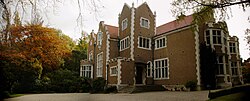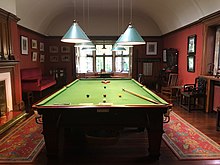
The University of Otago is a public research collegiate university based in Dunedin, Otago, New Zealand. Founded in 1869, Otago is New Zealand's oldest university and one of the oldest universities in Oceania.

Dunedin is the second-largest city in the South Island of New Zealand, and the principal city of the Otago region. Its name comes from Dùn Èideann, the Scottish Gaelic name for Edinburgh, the capital of Scotland. The city has a rich Māori, Scottish, and Chinese heritage.

Knox College is a selective residential college, founded and run by the Presbyterian Church of Aotearoa New Zealand and affiliated with University of Otago in Dunedin, New Zealand. The college is set in a 4.57 hectares landscaped site in Opoho on the opposite side of the Dunedin Botanic Gardens from the university. It is named after John Knox, a sixteenth century leader of the Scottish Reformation, whose efforts in establishing a universal system of free education comprising both academic learning and character formation had a profound influence, not just in Scotland, but internationally, as subsequent generations of Scottish settlers, products of the Scottish Enlightenment, emigrated to far-flung corners of the globe, including New Zealand, taking with them a deep-seated belief in the benefits of applied knowledge and a broad and liberal education. Those strong Scottish Presbyterian foundations are something that Knox College has in common with the university to which it is affiliated. They are depicted on the college's Coat of Arms in the form of a blue St Andrew's Cross. Superimposed on the St Andrew's Cross is the image of a white dove in flight, carrying an olive branch in its mouth, a symbolic depiction of the flood myth in Genesis 8, wherein the olive-branch-bearing dove is a symbol of life and peace. The college motto, Gratia et Veritas (Latin), or Grace and Truth (English), comes from the Prologue to the Gospel according to Saint John.

Larnach Castle is a mock castle on the ridge of the Otago Peninsula within the limits of the city of Dunedin, New Zealand, close to the small settlement of Pukehiki. It is one of a few houses of this scale in New Zealand. The house was built by the prominent entrepreneur and politician, William Larnach. Since 1967, the castle has been privately owned by the Barker family, and opened as a tourist attraction, as "New Zealand's only castle".
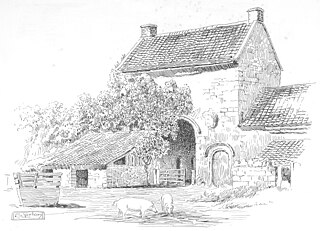
Olveston is a small village and larger parish in South Gloucestershire, England. The parish comprises the villages of Olveston and Tockington, and the hamlets of Old Down, Ingst and Awkley. The civil parish population at the 2011 census was 2,033. Alveston became a separate church parish in 1846. The district has been inhabited since the Stone Age, and the salt marshes that made up almost half of the parish, were progressively drained in Roman and Saxon times. A sea wall was constructed at the same time to prevent flooding from the nearby estuary of the River Severn.

Otago Polytechnic was a public New Zealand tertiary education institute, centred in Dunedin with additional campuses in Cromwell and Auckland. Otago Polytechnic provided career-focused education and training, offering a range of New Zealand accredited postgraduate qualifications, degrees, diplomas and certificates at levels 2–10. In November 2022, it was formally merged into the new national mega polytechnic Te Pūkenga, ending its existence as an independent entity.

Arthur Barnett Ltd, trading as Arthur Barnett and often referred to as Arthur Barnett's, was a department store in Dunedin, New Zealand. Established in 1903 by Arthur Barnett the store first began as a drapery for men and boys, progressing over the years to become one of Dunedin's most successful department stores. As well as their flagship George Street store, Arthur Barnett had stores in Balclutha, Alexandra, Oamaru, and Christchurch. They also briefly had a branch in Melbourne which operated from 1970 to 1977. This branch sold mainly carpeting and furniture. The final Arthur Barnett store and its online store was taken over by Invercargill-based department store chain H & J Smith in 2015.

The villages and then city that lay at the head of Otago Harbor never existed in isolation, but have always been a staging ground between inland Otago and the wider world. While Dunedin's current official city limits extend north to Waikouaiti, inland to Middlemarch and south to the Taieri River mouth, this articles focus is the history of the Dunedin urban area, only mentioning Mosgiel, the Otago Peninsula, Port Chalmers and inland Otago for context.

The Toitū Otago Settlers Museum is a regional history museum in Dunedin, New Zealand. Its brief covers the territory of the old Otago Province, that is, New Zealand from the Waitaki River south, though its main focus is the city of Dunedin. It is New Zealand's oldest history museum.
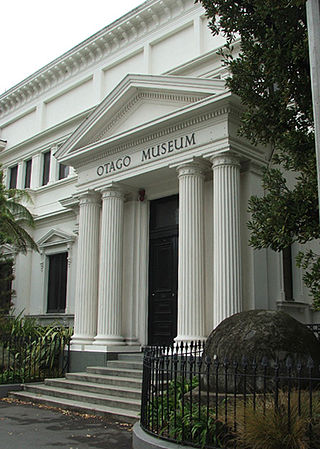
Tūhura Otago Museum is located near the city centre of Dunedin, New Zealand, adjacent to the University of Otago campus. The museum has one of the largest collections in New Zealand, and is one of the city's leading attractions. Natural science specimens and humanities artefacts from the Otago region and around the world form the basis for long-term gallery displays. An interactive science centre within the museum includes a large, immersive tropical rainforest butterfly house.

Globe Theatre is a theatre located in Dunedin, New Zealand, and the amateur theatre company that runs it. The theatre was built in 1961 by Patric and Rosalie Carey as an extension of their house. The building to which it is attached, at 104 London Street, was designed by architect William Mason as his own house and built in 1864. Ralph Hotere designed both sets and costumes for the theatre productions. The foyer area was also used for exhibitions, notably the Waterfall paintings of Colin McCahon, paintings by Michael Smither, and pots by Barry Brickell, Len Castle, and Doreen Blumhardt.

Sir Ernest George was a British architect, landscape and architectural watercolourist, and etcher.
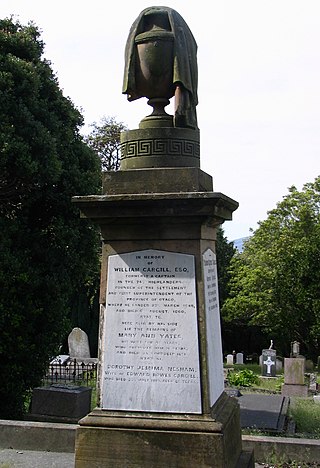
The Southern Cemetery in the New Zealand city of Dunedin was the first major cemetery to be opened in the city. The cemetery was opened in 1858, ten years after the founding of the city in an area known as Little Paisley. This area lies at the southern end of Princes Street, one of the city's main streets, close to the suburbs of Kensington, Maryhill, and The Glen.
Annette Grace Pearse was a New Zealand art gallery curator and director.

Mason & Wales is New Zealand's first architecture practice. They were the architects on Dunedin buildings the Wains Hotel (1878), Garrison Hall (1879), the Scott Building (1916) at the University of Otago Dunedin School of Medicine (1916) in Queenstown the Queenstown Police Station (1996).
Mary Eleanor Joachim (1874–1957) was a New Zealand book-binder in the Arts and Crafts tradition.

Caroline Freeman College is a residential college owned and operated by the University of Otago in Dunedin, New Zealand. The college is located a short distance north of the Otago central campus near the Dunedin Botanical Gardens.

Aaron Garth Hawkins is a New Zealand politician who served as the 58th mayor of Dunedin, New Zealand from 2019 to 2022. He was elected as Mayor on 12 October 2019 with 54.54% of the vote, after two prior terms as councillor. He is endorsed by the Green Party. He unsuccessfully stood for re-election as mayor in 2022.
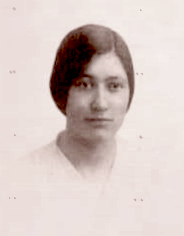
Dorothy Catherine Wentworth Jenkin was a New Zealand watercolorist, botanical illustrator and printmaker. She was a founding member of the Invercargill Art Society and participated in campaigning for a public art gallery in Invercargill. She was involved in ensuring the acquisition of Anderson Park and the establishment of the Invercargill Art Gallery at that location. Many of her works are held at the Rakiura Museum and have been reproduced as prints and postcards.
